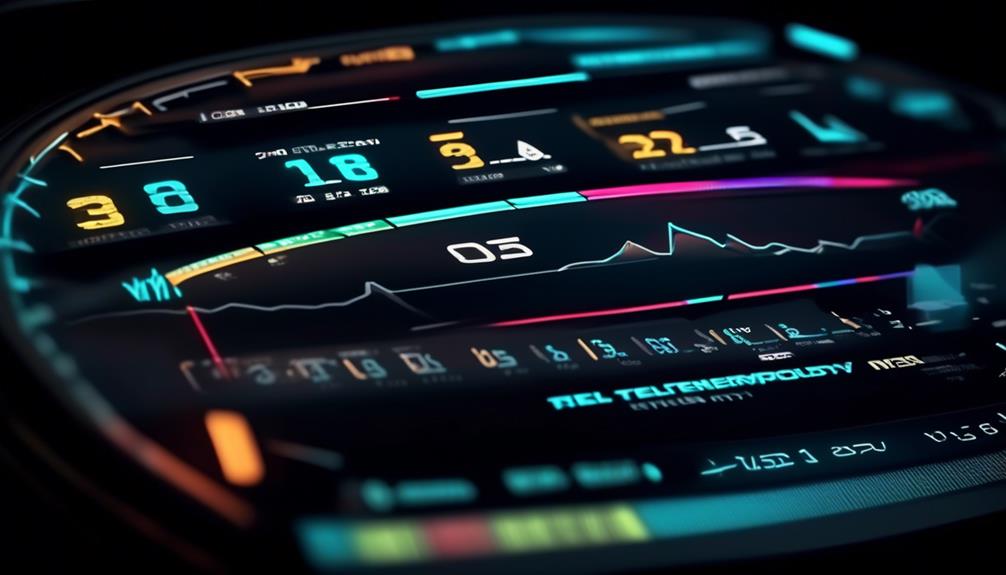They say that knowledge is power, and when it comes to sim racing, analyzing telemetry data can be the key to unlocking your true potential on the virtual track.
By harnessing the power of advanced technology, you can gain valuable insights into your driving performance and make informed decisions on how to improve.
But where do you start? How do you make sense of all those numbers and graphs?
In this discussion, we will explore the art of analyzing telemetry data in sim racing, guiding you through the process of understanding, collecting, and interpreting this valuable information.
Get ready to take your racing skills to the next level, as we unveil the secrets hidden within the data, waiting to be discovered.
Key Takeaways
- Telemetry data is essential for gaining insights into performance and making informed decisions to improve sim racing skills.
- Analyzing telemetry data helps identify areas for improvement, such as braking points, speed optimization, and racing line.
- Comparing telemetry data between laps helps identify faster and slower sections.
- Analyzing telemetry data with a reference lap helps pinpoint areas for improvement.
Understanding Telemetry Data
Understanding telemetry data is essential for gaining insights into your performance and making informed decisions to improve your sim racing skills. Telemetry data is the collection of various measurements and information about your car's performance on the track. It includes data on throttle input, braking, speed, and the racing line you take throughout a lap.
By analyzing telemetry data, you can identify areas where you may be losing time or making mistakes. For example, you can see if you're braking too early or too late, if you aren't maximizing your speed on straights, or if you aren't taking the optimal racing line through corners. This information allows you to make adjustments and refine your driving technique to improve your lap times.
Additionally, telemetry data can help you optimize your car setup for different tracks and conditions. By analyzing the data, you can fine-tune your suspension, aerodynamics, and other settings to maximize performance and ensure a competitive edge.
To effectively analyze telemetry data, you need to understand how to interpret the various measurements and charts provided. This may require some knowledge of racing dynamics and vehicle physics. However, there are resources available, such as videos, software, and online platforms, that can help you learn the necessary skills.
Collecting Telemetry Data
To effectively analyze telemetry data, it's important to have a reliable method for collecting the data from your sim racing game. One such method is using SRT Sim Racing Telemetry, which can be utilized on various platforms including PC, PlayStation, Xbox, and Mac.
This cross-platform solution offers features like exporting data to CSV, per-lap information, laps comparison, mathematical statistics, and interactive charts with a reconstructed track view. With SRT, you can enhance your in-game performance and optimize your driving performance based on data. The sharing feature even allows you to compare telemetries with others.
However, it's crucial to be aware of copyright and legal information concerning the use of telemetry data. Collecting telemetry data in sim racing is vital for identifying errors, measuring improvement, understanding driving performance, and optimizing car setups.
Interpreting Telemetry Data
When analyzing telemetry data in sim racing, it's essential to carefully interpret the recorded data from the vehicle's performance during a race or session. The data acquisition tools available in sim racing provide valuable insights that can help you improve your skills and optimize your car setup.
One important aspect to consider is the racing line data. By reviewing the speed tab and analyzing the vertical y-axis, you can identify areas where you may be hindering your exit speed. For example, if you notice that the blue driver stays at the minimum speed for a longer time compared to the orange driver, it may indicate that you're braking too soon or not gradually inclining the throttle to achieve the later apex.
Additionally, reviewing the brake pedal and throttle inputs can provide valuable information. If you see the blue driver quickly getting to full brake pressure, it means more time spent at the minimum speed, which can be detrimental to your overall performance.
Understanding the racing line fully is crucial in sim racing, and using telemetry data can help you analyze and improve your driving techniques.
Identifying Performance Areas
To effectively identify performance areas in sim racing, compare telemetry data between laps to pinpoint faster and slower sections. By analyzing the throttle data, you can determine the differences in throttle usage between drivers and how it impacts their performance. Look for variations in the incline of throttle pressure and the minimum speed that drivers hit.
A driver who quickly hits the minimum speed and increases throttle pressure, which lifts the car, can have a significant impact on their exit speed. This can be hindering if the driver doesn't maintain the appropriate distance and vertical incline, causing the car to lose traction. To optimize exit speed, focus on maintaining a wider exit.
Additionally, evaluate braking data to understand differences in braking techniques, as this can affect corner entry and exit speed. By comparing racing lines alongside speed and reference lap data, you can optimize your approach to corners and improve lap times.
Implementing Changes for Better Results
By implementing changes based on the analysis of telemetry data, you can make adjustments to your driving style, vehicle setup, and racing line to achieve better results in sim racing. Telemetry data provides valuable insights into your performance on the track, allowing you to identify areas for improvement and make targeted changes.
One way to use telemetry data effectively is by comparing it with a reference lap. By analyzing the differences in throttle usage, braking techniques, and cornering speeds between your telemetry data and the reference lap, you can pinpoint specific areas that need improvement. For example, if you notice that your exit speed is hindered by a delay in getting back on the throttle, you can focus on improving your throttle control to maintain a higher speed out of corners.
Another useful technique is to break down the telemetry data into segments and analyze each segment individually. This allows you to identify patterns and trends in your driving performance. For instance, if you see an incline on the graph during braking, it might indicate that you're applying too much pressure too quickly. Adjusting your braking technique to have a smoother and more gradual application of brakes can lead to better overall performance.
Furthermore, sharing your telemetry data with friends and fellow sim racers can provide valuable insights and potential areas for adjustment. By comparing telemetries, you can learn from each other's strengths and weaknesses and make informed changes to your driving style or vehicle setup.
In addition to analyzing your driving style, telemetry data can also help optimize your vehicle setup. By studying the telemetry data, you can identify areas where adjustments to the car's setup can lead to improved performance. For example, if you find that you consistently have a shallow entry into corners, adjusting the car's suspension or aerodynamics can help you carry more speed through the corner.




